Overview
Left: A Map of Villanova Mondovì and the Surrounding Area; Right: Main Street in Villanova
In May 2013, we spent two weeks in Villanova Mondovì, a comune in the Province of Cuneo. We were there visiting family, some in Villanova Mondovì, and others in nearby towns. About half of our time was spent with family (eating and visiting), the other half we had time to explore.
We stayed at the fabulous, friendly, and well-appointed Albergo della Ceramica. This choice couldn’t have been better for us. The hotel is within a few minutes walk to the main square of Villanova.
During the 19th century, Villanova and many other towns in the area became famous for their ceramics. The abundance of limestone in the area was the base of the ceramics industry, which suffered in the last half of the 20th century as cheaper pottery started arriving from other parts of the world. The Albergo della Ceramica was an important ceramics factory, which now, to our benefit, is a wonderful hotel. Off the main reception area, there is a room where you can pick up a few pieces still made in the area, with typical regional designs. And, beautiful and historical pieces are thoughtfully used for decoration throughout the Albergo. (Hopefully, in another post we’ll talk about the Museo della Ceramica in Mondovi – 15 minutes by car from Villanova. This is well worth a visit if you like pottery.)
Villanova and the surrounding area is also known for its high quality gravel. In fact, the town is dominated visually and noise-wise by the large extraction and aggregate processing operation run by Giuggia Costruzioni. Giuggia produces, among other things, material for making roads.
Villanova Mondovì, as of 2011, had just under 6,000 inhabitants. There are not a lot of restaurants or shopping choices in Villanova Mondovì, but the basics are there and we were fine with that. We knew where the pharmacy (farmacia) was and our favorite restaurant, Cavallo Rosso, è basta! In some ways, it was a nice experience to be the only tourists in a small Italian village. It felt like we had it to ourselves. One day, we took a trip to La Morra and ran into other tourists like us. It was almost, well, not very pleasing.
Scenes Around Villanova Mondovì: A Cappella, Lime Trees, Main Church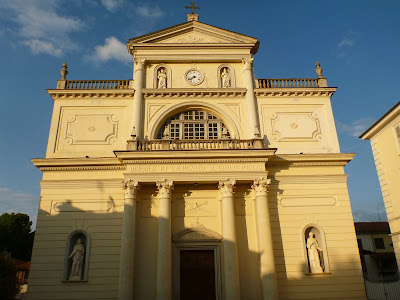
Places We Visited Around Villanova Mondovì
Santuario Sant Lucia
We parked at the bottom of the hill (near the pizzeria) one morning, and walked up to the sanctuary (sanctuario). It wasn’t open, so we continued on a hike that if we had finished would have taken us by the mine and up to Monte Calvario. However, we turned around after a bit and as we arrived back at the Santuario, were pleased to find that it was now open. We stepped inside and met Raffaella (a novice) who showed us around a bit and gave us some of the famed water – purported to be good for healing ailments of the eyes. It was a very surreal morning. The santuario seems not to be in use currently and time is slowly taking hold of it. We heard stories of how the santuario played a part in World War II and how the cave at the back of the main chapel (really) connects up to Grotta dei Dossi.
Scenes from Santuario Santa Lucia
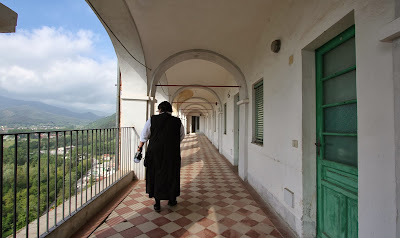
Villavecchia
VIllavecchi is the older part of Villanova Mondovì. Villavecchia means literally “old mansion” and refers to the fortress/fortified town that capped the hill. Our morning ritual for the two weeks was to walk from Albergo della Ceramica up to Villavecchia, take in the view, and then return back to the albergo for breakfast.
One morning, a local resident/journalist (G.B. Rulfi) gave us a tour of the Antica Chieisa di Santa Caterina and it’s austere interior with chipped “picchiati” frescoes. After the plague, they chipped existing frescoes to make the surface ready for another layer of plaster. Re-plastering was to keep the plague from returning. Attached to the church is the Torre Civica. We peeked up inside the tower. It didn’t look like it should be climbed and so we didn’t.
Villavecchia Villanova Mondovì: Antica Chiesa du Santa Caterina and Other Buildings Around the Piazza
The next stop on our tour of Villavecchia was the parochial church just next door. The final stop on our tour was the Monastero di Suore, Missionarie Passione Nostro Signore Gesu’ Cristo. There, we ran into Raffaella from the Santuario and one her colleagues, Suor Veronica. The smell of lunch was making me hungry as we visited the tomb of Madre Maria Margherita Lazzari.
Cascinale dei Frati
Continuing on the tour with G.B. Rulfi, we ended up in the borgata of Casale Bertini, just south of Roccaforte Mondovì, at a cluster of old farm buildings. The farm was once Cascinale dei Frati – a 15th century monastery built by local Carthusian monks. The remaining frescoes are from the monastery are beautiful. Pull into the farmyard, watch out for animals and people, park, and climb to the second story balcony to view the frescoes.
Cascinale dei Frati and Gelato Display in Nearby Roccaforte Bar dell’Olmo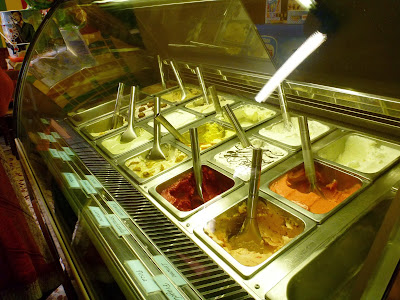
Monte Calvario
If you continue following the road leading up from Villavecchia, you’ll end up at Monte Calvario where you can take in the view of the Piemonte plain to the north.
La Grotta dei Dossi
This area is known for its karst activity and Grotta dei Dossi is a place you can see it in action. Dossi is billed as “La grotta più colorata d’Italia.” And, it is reported to be the first cave to be illuminated with electric light in Italy. When we were there (late May) the presepe were still on display! For more info, see Showcaves.
The last time we were in Piemonte, we went to the Grotta di Bossea.
Left: Inside Grotta dei Dossi; Center: View from Monte Calvario Looking North; Right: View of Extraction Process in Villanova Mondovì
Food
Cavallo Rosso [Villanova Mondovì]. In the center of Villanova, this was our go-to restaurant. We ate here many times.
Pasticceria Denina [Villanova Mondovì]. A shop that has “Specialità Villanovesi”, in particular, the wrapped truffle-like sweets that come in different flavors. We noticed that the wrappers feature two people “Trumé e Carlotta”. According to the comune site, “Trumé and Carlotta” is a mark adopted by the town to ensure that the goods with this mark are original and of good quality.
L'amministrazione comunale ha adottato un marchio d'impresa collettivo denominato "Trumè e Carlotta" allo scopo di garantire al consumatore "l'origine" e "la qualità" delle merci e dei servizi prodotti e commercializzati dagli imprenditori villanovesi.
The comune site says the legend of the two (a man and a woman, we suppose) is tied up in the town’s uprising against some pesky Huguenots.
Pasticceria Denina Display and Sweets
Ca' del Pian [Paganotti, near Villanova]. We went here for a farewell lunch, and then spent some quality time with the goats on a nearby farm.
Bar dell’Olmo [Roccaforte]. In the center of Roccaforte, a typical village “bar”, but with award winning gelato!
Bar del Viale [Villanova Mondovì]. Simple, good food perfect for a lunch. Friendly service.
An article, tangentially about our visit, is here in the Provincia Granda: In visita a Villanova gli americani che parlano piemontese, by G.B. Rulfi.
Left: View from Paganotti, Ca’ del Pian – Looking North; Center: View from Paganotti, Ca’ del Pian – Looking South; Right: A Cat on a Car on the Way to Villavecchia
Left: Plates on the Wall of Albergo della Ceramica; Center: Entrance of Albergo della Ceramica; Right: View of Villavecchia
Additional Resources
La Grotta dei Dossi Brochure
Sentieri e natura Villanova Mondovì
Piccola guida per tutta la famiglia all Rete Sentieristica di Villanova e alla natura nei dintorni.






















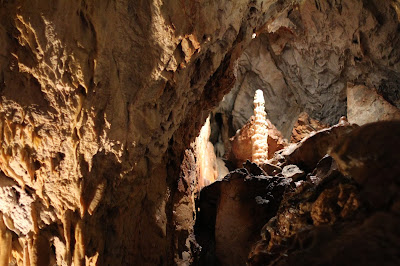


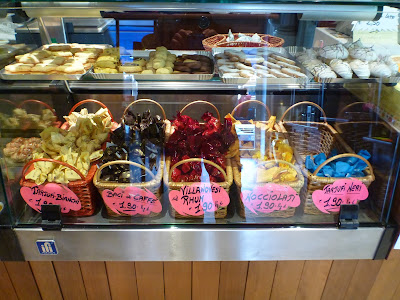


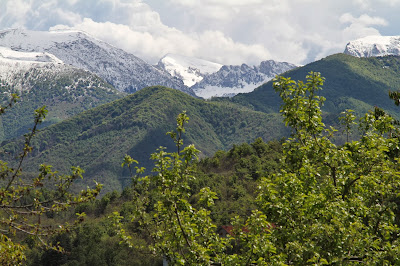




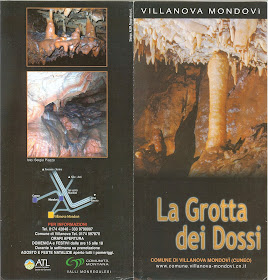









No comments:
Post a Comment
All comments are moderated. If your comment doesn't appear right away, it was likely accepted. Check back in a day if you asked a question.